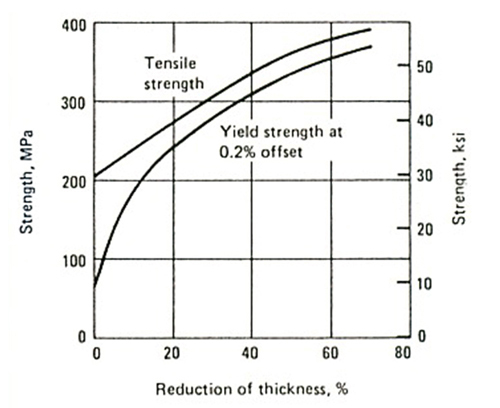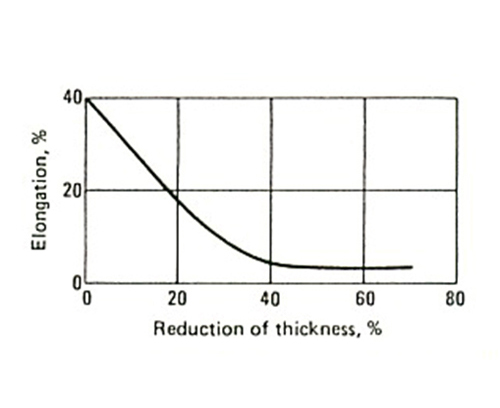Copper Alloys C11000 ETP
|
Product Data Sheet Copper AlloysElectrolytic Tough Pitch Copper (ETP Copper) Alloy 110 UNS-C1100 |
Chemical CompositionAS2738.2-1984 Copper 99.90+%, oxygen by agreement, usually 0.04% Equivalent Alloy Specifications
Australian Product Specifications
Other product specifications available on enquiry ASTM Product Specifications
Mechanical PropertiesAS1566, Sheet & Strip
1. Properties marked * are typical, for information only Finish Annealed or cold rolled to temper. Availablilty Austral Wright Metals can supply this alloy in sheet, strip, coil, plate, circles, bar, sections, wire. General Description Electrolytic tough pitch (ETP) copper, alloy 110, has excellent ductility and high electrical and thermal conductivity, higher than for any other copper metal except oxygen free grades such as C10200. The electrical conductivity is at least 100% IACS (0.5800 microhm?¹.cm?¹) and is often as high as 101.5% IACS. Electrical and heat exchanger uses are common. The dominant use of this alloy is in electrical conductors. It is also used widely for gaskets, switches, terminals and connectors, transformers, electronic parts, ball floats, drawn and spun holloware. Physical Properties
Fabrication Properties
Joining Properties
Corrosion ResistanceC11000 has excellent corrosion resistance to weathering and very good resistance to many chemicals. It is often used specifically for corrosion resistance. It is suitable for use with most waters, and can be used underground because it resists soil corrosion. It resists non-oxidising mineral and organic acids, caustic solutions and saline solutions. Acids mineral acids such as hydrochloric and sulphuric acids; organic acids such as acetic acid (including acetates and vinegar), carbolic, citric, formic, oxalic, tartaric and fatty acids; acidic solutions containing sulphur, such as the sulphurous acid and sulphite solutions used in pulp mills. Alkalies fused sodium and potassium hydroxide; concentrated and dilute caustic solutions. Salt solutions aluminium chloride, aluminium sulphate, calcium chloride, copper sulphate, sodium carbonate, sodium nitrate, sodium sulphate, zinc sulphate. Waters all potable waters, many industrial and mine waters, seawater and brackish water. Other media The corrosion resistance of C11000 is not adequate for: ammonia, amines and ammonium salts; oxidizing acids such as chromic and nitric acids and their salts; ferric chloride; persulphates and perchlorates; mercury and mercury salts. Copper may also corrode in aerated non oxidising acids such as sulphuric and acetic acids, although it is practically immune from these acids if air is completely excluded. Copper is not suitable for use with acetylene, which can react to form an acetylide which is explosive. C11000 is considered to be immune to stress corrosion cracking in ammonia and the similar media which cause season cracking in brass and other copper alloys. Consult Austral Wright Metals for your specific application. WeldingC11000 contains about 0.04% oxygen, as cuprous oxide. This intentional residue reduces the adverse effect on electrical conductivity of traces of impurity metals. The internal oxide renders the alloy subject to hydrogen embrittlement if heated in reducing atmospheres above about 370°C (dull red heat). C11000 is therefore unsuitable for gas welding and high temperature brazing. Oxygen free copper, C10200, or the deoxidised alloy C12200 is preferred where welding is required. Effect of cold work on Mechanical PropertiesCopper in the annealed condition is among the most ductile of the engineering metals. Cold work, either cold rolling or deformation in fabrication, leads to rapid work hardening. The tempered grades of copper are produced by cold work, and the commercially pure coppers cannot be hardened by heat treatment.
Change of mechanical properties with cold reduction by rolling. | ||||||||||||||||||||||||||||||||||||||||||||||||||||||||||||||||||||||||||||||||||||||||||||||||||||||||||||||||||||||||||||||||||||||||||||||||||||
The technical advice and recommendations made in this Product Data Sheet should not be relied or acted upon without conducting your own further investigations, including corrosion exposure tests where needed. Please consult current editions of standards for design properties. Austral Wright Metals assumes no liability in connection with the information in this Product Data Sheet. Austral Wright Metals supplies a comprehensive range of stainless steels, copper alloys, nickel alloys and other high performance metals for challenging service conditions. Our engineers and metallurgists will be pleased to provide further data and applications advice. |



